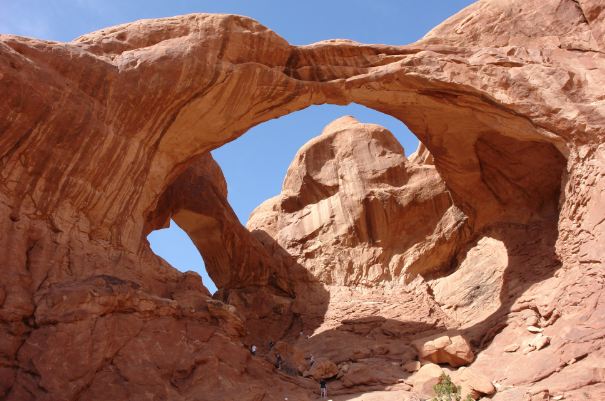Million years ago, the surface of an expansive salt bed underwent extreme climate changes. Debris from Ocean waters and flood were compressed into rock, and push the earth down into hollow pockets and upward into domes. Because of these conditions, faults and vertical arches formed. These arches are unique structures, and there is one location with the highest density of natural sandstone arches in the world. This is the Arches National Park.
ABOUT THE PARK
The Arches National Park, situated in Moab, southwestern Utah, houses more than 2,000 natural sandstone arches, giant stone bluffs, red-rock canyons, and pinnacles. Adjacent to the Colorado River, the park consists of 76, 679 acres of high desert located on the Colorado Plateau.
No stranger to highs and lows, its highest elevation reaches 5,653 feet at Elephant Butte, and its lowest elevation drops to 4,085 feet at the visitor center. It is often visited during the Summer. However, it often reaches over a hundred degrees. Winter is the season in which the park meets the least number of visitors, wherein it occasionally snows.
HISTORY OF THE PARK
Occupied since the last ice age 10,000 years ago and housing the Fremont people and ancestral Puebloans 700 years ago, the place has petroglyphs and remnants of those who inhabited the area.
This location first caught the eye of the National Park Service by Frank Wadleigh. He, accompanied by George L. Beam, a railroad photographer, visited in September 1923 because of an invitation from Alexander Ringhoffer. Ringhoffer had contacted them to express his interest in the place’s tourism potential. Wadleigh, impressed by the area’s sights, suggested to Park Service director Stephen Mather for the place to be declared a national monument.
In 1926, the Park Service supported the area as a national monument but was resisted by Interior Secretary Hubert Work. In April 1929, though, shortly after his inauguration, former President Herbert Hoover signed the proclamation that declared the Arches area a national monument. Frank Pinkley suggested the name Arches.
In 1971, former President Richard Nixon changed its status to a national park. The Arches National Park’s Delicate Arch was featured as the third 2014 quarter of the U.S. Mint’s America the Beautiful Quarters program.
ATTRACTIONS OF THE PARK’
- Balanced Rock
This is one of the park’s top sights where visitors can see a large rock, the size of three school buses, balanced and perched on top of a 128-feet towering rock formation. Although it isn’t literally balancing itself and instead firmly attached to Dewey Bridge Mudstone’s pedestal, it still is an epic feature of the park.
- Park Avenue and Courthouse Towers
This area covers a vast collection of stone columns. These can be viewed from the Park Avenue Viewpoint and Trailhead. Hikers could take such route or enjoy a 360-degree panoramic from a relatively flat sandstone bench in the La Sal Mountains Viewpoint.
- Delicate Arch
As a must-see, this iconic arch can be viewed from the Lower Delicate Arch Viewpoint, which is recommended for people who use wheelchairs, or the Upper Delicate Arch Viewpoint. The Delicate Arch is a lone-standing arch that has become the most recognized arch of the park and the symbol of its homing state, Utah. Its image has also appeared on U.S. Postage stamps and state license plates.
- Devils Garden and Landscape Arch
One of the park’s premier attractions, the Devils Garden, has arches, spires, and a large concentration of “fins,” narrow rock walls. The latter rock formation forms when rainwater erodes parallel fractures caused by the salt deposit uplift from below the surface. Fins will then eventually erode and form arches like the Landscape Arch, which is the crown jewel of Devils Garden.
Known as the longest arch in North America’s continent, the Landscape Arch is very thin and long, at a span of 290 feet. It is named the fifth-longest in the world.
- Double Arch
Two arches meet at a common end and in this park, are called the Double Arch. If Landscape Arch is the longest, Double Arch is the tallest at 112 feet. It also takes second place in the contest of the longest arch in the park at 144 feet. Without the need to hike, tourists can spot it from the parking area.
FACTS ABOUT THE PARK
Although it has been mentioned earlier that there are 2000 arches in the park, this number can always change as time passes because of some collapse while some are discovered throughout time.
Most animals that inhabit the area are either crepuscular or nocturnal to avoid the blazing heat during the daytime. Crepuscular animals are active at dawn and dusk, while Nocturnal creatures are active at night.
Lastly, the park is a top spot for astronomy-lovers and stargazers. Appreciation for astronomy blooms popularly in the park because of the dark skies and little pollution. Other than stargazing, people can also hike, camp, bike, backpack, and tour around this marvelous park. There’s just so much to do and see when in the Arches National Park.

